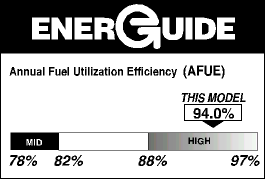An assumption is made here that all the energy from the fuel is released, and all the heat is available to heat the place. However, generally, when a fuel is burned in a furnace, not all the energy (heat) is available for the final end user.
The energy efficiency of a furnace is not 100 percent. Not all the energy from the fuel is released, and not all the heat is available to heat the place. For example, if a furnace’s efficiency is, say, 50 percent, then twice as much fuel would be needed to heat a home.
Looking again at the table on the previous screen, we saw that the heating value of fuel oil is given as 140,000 BTUs. However, if the furnace’s efficiency is 50 percent, then the actual heating value of fuel oil is 140,000 BTUs x 0.5 (efficiency) = 70,000 BTUs. In other words, when a gallon of oil is burned, 70,000 BTUs of heat is actually available to the user.
| Fuel | Unit | Heating Value (BTU's) | If Efficiency = 50 % |
|---|---|---|---|
| Natural Gas | CCF (100 Cu. ft) or Therm | 100,000 | 50,000 |
| Natural Gas | MCF (1,000 Cu.ft) | 1,000,000 | 500,000 |
| Fuel Oil | Gallon | 140,000 | 70,000 |
| Electricity | kWh | 3,412 | 1706 |
| Propane | Gallon | 91,300 | 45,650 |
| Bituminous Coal | Ton | 23,000,000 | 11,500,000 |
| Anthracite Coal | Ton | 26,000,000 | 13,000,000 |
| Hardwood | Cord | 24,000,000 | 12,000,000 |
Efficiency of a Furnace
The table below contains the data from a line plot showing the efficiency of a furnace. The percent efficiency is dependent on the heating value of fuel oil (measured in BTU) and shows a strong positive correlation.
| Efficiency of a Furnace | Heating Value of Fuel Oil (BTUs) |
|---|---|
| 50% | 70000 |
| 55% | 77000 |
| 60% | 84000 |
| 65% | 90000 |
| 70% | 100000 |
| 75% | 105000 |
| 80% | 111000 |
| 85% | 122000 |
| 90% | 125000 |
| 95% | 131000 |
| 100% | 140000 |
It can be clearly seen that as the efficiency of the furnace increases, the amount of heat available increases proportionally.
The higher the efficiency, the less oil needs to be put into the furnace to get the same amount of heat output.
Most of the heating furnaces burn fuel and release hot combustion gases. The hot combustion gases heat the incoming cold air and go out through the chimney. In older furnaces, all the heat in the fuel is not released or not transferred to the cold air (or water, in the case of heat registers and water heaters), and therefore is lost through the chimney. The air or water that is heated distributes the heat throughout the house. Newer models of furnaces have gotten better at getting more of the heat into the cold air and, therefore, into your house.
Click the play button and observe how a wood burning furnace operates at 75% efficiency.
Click here to open a text description of How a Wood Furnace Operates
How a Wood Burning Furnace Operates
Cold combustion air from outside is pulled into the furnace combustion chamber by an electric blower. The wood fire in the chamber heats the air to 1 million BTUs. The hot combustion gasses heat the cold, outside air to 750,000 BTUs, which will circulate through the house. The combustion gasses (250,000 BTUs) travel out through the chimney.
Furnaces are usually not as efficient when they are first firing up as they are running at steady-state. It is sort of like a car getting better mileage in steady highway driving than in stop-and-go city traffic.
What matters over the course of the year is the total useful heat the furnace delivers to your house versus the heat value of the fuel it consumes. This is kind of like measuring the gas mileage your car gets by asking how many miles you drove this year and dividing it by how many gallons of gas you bought.
For furnaces, they call this measure the AFUE (Annual Fuel Utilization Efficiency). The federal minimum-efficiency standards for furnaces and boilers took effect in 1992, requiring that new furnace units have an AFUE of at least 78 percent and new boiler units have an AFUE of at least 80 percent. In comparison, many old furnaces and boilers have AFUE ratings of only 55 to 65 percent.

To find out how efficient your furnace is, look for an energy guide label like this:
The table below gives the efficiencies of most efficient furnaces that were available in 2002–2003.
| Fuel | Furnace Type | Efficiencies (%) |
|---|---|---|
| Natural Gas | Hot air | 93.0 - 96.6 |
| Natural Gas | Hot Water | 83.0 - 95.0 |
| Natural Gas | Steam | 81.0 - 82.7 |
| Fuel Oil | Furnace | 83.8 - 86.3 |
| Fuel Oil | Hot Water | 86.0 - 87.6 |
| Fuel Oil | Steam | 82.5 - 86.0 |
When buying a new furnace, make sure its heating capacity (output) is appropriate for your home. If the insulation and/or windows in your home have been upgraded since the old heating equipment was installed, you can probably use a much less powerful furnace or boiler. Oversized furnaces operate less efficiently because they cycle on and off more frequently; in addition, larger furnaces are more expensive to buy.
